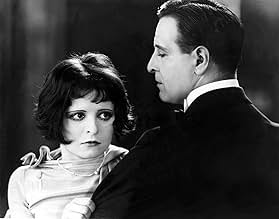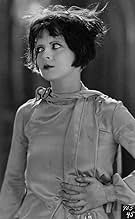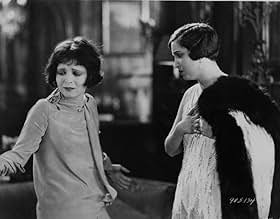Aggiungi una trama nella tua linguaA young girl becomes a "flapper", defying her parents and the community.A young girl becomes a "flapper", defying her parents and the community.A young girl becomes a "flapper", defying her parents and the community.
- Regia
- Sceneggiatura
- Star
- Premi
- 2 vittorie totali
Recensioni in evidenza
Dancing Mothers is definitely a product of its time. It is the era of the flapper, when morality flew out the window and people were up for having a good time. Alice Joyce plays Ethel Westcourt, a lonely wife and mother whose family abandons her for the fun of nightclubs. Her daughter Kittens (Clara Bow) is particularly wild and pays far too much attention to playboy Jerry Naughton (Conway Tearle). Ethel decides she's tired of waiting around the house; she takes matters into her own hands and goes to the club her daughter frequents. There, she gets close to Jerry, in an attempt to lure him away from her daughter, but her plan backfires when he falls for her but her daughter just won't let go.
Famous today simply for the presence of effervescent Bow, this movie is an entertaining look into the Roaring Twenties era that she symbolizes. Bow takes up quite a lot of this film, which is exciting, since most of her early appearances are scant at best. Joyce makes a good impression as well; she is beautiful and a competent actress.
The music score provided by Grapevine Video isn't bad at all and suits the film nicely.
Famous today simply for the presence of effervescent Bow, this movie is an entertaining look into the Roaring Twenties era that she symbolizes. Bow takes up quite a lot of this film, which is exciting, since most of her early appearances are scant at best. Joyce makes a good impression as well; she is beautiful and a competent actress.
The music score provided by Grapevine Video isn't bad at all and suits the film nicely.
Dancing Mothers is a rather dull film except for the vivacious Clara Bow playing "Kittens." Also of interest are the truly ugly sets (check out the hideous pirate-themed nightclub) and the great women's clothes. Clara Bow wears some really bizarre outfits as the jazz baby who sets her sights on Conway Tearle, who plays a "famed lady killer." Tearle is old and dull but was a star in 1926. Alice Joyce is the nominal star. She was billed as "the madonna of the screen," but shows little vitality here as the mother who decides to "live." Dorothy Cumming (whose named is misspelled as "Cummings" in the credits) is good as Mazzy, and Leila Hyams, Donald Keith, Norm Trevor, and Eleanor Lawson round out the supporting cast. Worth seeing for the always-good Clara Bow and for the shocking ending. The whole film seemingly leads up to the conventional ending, but then takes a different route. Dancing Mothers was a big hit in 1926 and helped make Bow one of the biggest stars of the last 20s.
clara bow plays "kittens westcourt," a spoiled girl of wealthy parents. she spends her evenings dancing and partying all night long at clubs, which her father also attends. her mother stays at home wondering why her family is so selfish, and neglectful towards her. one day a friend tells mom to start living it up. she takes this advice and is soon off to the dance clubs herself. kittens and mother then proceed to compete for the same man's affections. above average clara bow film. she is not the lead actress in the film, but she has lots of screen time. clara is funny, full of energy, and just wonderful.
DANCING MOTHERS (Paramount, 1926), directed by Herbert Brenon could very well be a backstage musical about young wives choosing theatrical careers in the chorus line over being stay-at-home moms. In spite of a promising idea for such a title, DANCING MOTHERS is actually a drama featuring society types, notably women in fur coats, expensive dresses, smoking with cigarette holders and riding in a rolls Royce. Taken from the play by Edgar Selwyn and Edmund Goulding, it depicts upon one particular mother, taken for granted by her family, who chooses to break away from her lonely existence by stepping out to enjoy life, much to the dismay of her cheating husband and selfish/ carefree daughter.
The story begins on an ocean liner, "Homeward bound for America - the first day out" where debonair playboy Jerry Naughton (Conway Tearle), traveling along with his companion, Irma Raymond (Elsie Lawson), meets Catherine "Kittens" Westcourt (Clara Bow), a youthful flapper, and her wealthy father, Hugh (Norman Trevor), on deck. On "their last day out," Kittens and Jerry have become inseparable while her father and Irma have become romantically involved. As the ship docks New York, Mrs. Westcourt (Alice Joyce), the once famous Ethel Wright who "On December 13, 1907, abandoned her stage career to marry the wealthy banker," awaits their arrival, but their union as a family is short lived. "And so it went on ... for a fortnight the Westcourt country home had seen little of Ethel's husband and daughter." As Ethel continues having dinner alone in her luxurious mansion, Hugh and Kittens dine separately at the Pirate's Pub Cafe, he with Irma and she along with beau, Kenneth Cobb (Donald Keith), and girlfriend, Birdie Courtney (Leila Hyams). After Hugh telephones Ethel for "being called away to Philadelphia on Russian business" and Kittens to call saying she's "spending the evening" with Birdie, Ethel takes the advise from Mrs. Mazzarene (Dorothy Cumming), her widowed friend, to accompany her at the Roof Club to start living. Also there are Kittens and Jerry, as well as Hugh with his "Russian business." As the evening progresses, Ethel encounters Jerry Naughton. Discovering he to be the one romancing her daughter, she passes herself off as Yvonne De Bresac, a French socialite. True love prevails until Ethel and Jerry are caught embracing in his apartment by both her daughter and husband.
As much as DANCING MOTHERS is regarded to be both a jazz age story and a Clara Bow starrer, this 64 minute drama rightfully belongs to the sophisticated Alice Joyce, a notable star of the silent screen whose name is as forgotten as her leading man, Conway Tearle. Bearing a slight resemblance of Mary Astor, and known solely for playing society types, Joyce is as prominently cast as the respectable old-fashioned wife who proves not to be vulnerable as she appears. Of her many films dating back to 1910, only DANCING MOTHERS, along with STELLA DALLAS (1925) and BEAU GESTE (1926, also directed by Brenon) are most associated with her and much essayed by film scholars. Clara Bow, better known as the "It" girl of her time, lives up to her reputation as the typical fun loving, self centered daughter who addresses her own mother as "Buddy."
Rarely revived in recent years, DANCING MOTHERS has enjoyed occasional revivals in the public broadcast television series, "The Toy That Grew Up" (1965-1972), and later part of a large selection of silents distributed to home video from various distributors as Grapevine and Video Yesteryear. For the Grapevine collection in both VHS and DVD formats, DANCING MOTHERS contains an acceptable orchestral score playing such popular twenties tunes as "Has Anybody Seen My Gal?" during party sequences, most likely the print acquired from reissues distributed during the early sound era.
For its premise and surprisingly timely theme, DANCING MOTHERS might have served equally well for Depression era audiences of the 1930s with possible casting of Ruth Chatterton, Lionel Barrymore, Ricardo Cortez and Mary Carlisle in the Joyce, Trever, Tearle and Bow roles, or serve as the basis for a Lana Turner /Sandra Dee movie in the 1960s. As much as DANCING MOTHERS is a reflection of the roaring twenties, it's quite a novelty, too. (***)
The story begins on an ocean liner, "Homeward bound for America - the first day out" where debonair playboy Jerry Naughton (Conway Tearle), traveling along with his companion, Irma Raymond (Elsie Lawson), meets Catherine "Kittens" Westcourt (Clara Bow), a youthful flapper, and her wealthy father, Hugh (Norman Trevor), on deck. On "their last day out," Kittens and Jerry have become inseparable while her father and Irma have become romantically involved. As the ship docks New York, Mrs. Westcourt (Alice Joyce), the once famous Ethel Wright who "On December 13, 1907, abandoned her stage career to marry the wealthy banker," awaits their arrival, but their union as a family is short lived. "And so it went on ... for a fortnight the Westcourt country home had seen little of Ethel's husband and daughter." As Ethel continues having dinner alone in her luxurious mansion, Hugh and Kittens dine separately at the Pirate's Pub Cafe, he with Irma and she along with beau, Kenneth Cobb (Donald Keith), and girlfriend, Birdie Courtney (Leila Hyams). After Hugh telephones Ethel for "being called away to Philadelphia on Russian business" and Kittens to call saying she's "spending the evening" with Birdie, Ethel takes the advise from Mrs. Mazzarene (Dorothy Cumming), her widowed friend, to accompany her at the Roof Club to start living. Also there are Kittens and Jerry, as well as Hugh with his "Russian business." As the evening progresses, Ethel encounters Jerry Naughton. Discovering he to be the one romancing her daughter, she passes herself off as Yvonne De Bresac, a French socialite. True love prevails until Ethel and Jerry are caught embracing in his apartment by both her daughter and husband.
As much as DANCING MOTHERS is regarded to be both a jazz age story and a Clara Bow starrer, this 64 minute drama rightfully belongs to the sophisticated Alice Joyce, a notable star of the silent screen whose name is as forgotten as her leading man, Conway Tearle. Bearing a slight resemblance of Mary Astor, and known solely for playing society types, Joyce is as prominently cast as the respectable old-fashioned wife who proves not to be vulnerable as she appears. Of her many films dating back to 1910, only DANCING MOTHERS, along with STELLA DALLAS (1925) and BEAU GESTE (1926, also directed by Brenon) are most associated with her and much essayed by film scholars. Clara Bow, better known as the "It" girl of her time, lives up to her reputation as the typical fun loving, self centered daughter who addresses her own mother as "Buddy."
Rarely revived in recent years, DANCING MOTHERS has enjoyed occasional revivals in the public broadcast television series, "The Toy That Grew Up" (1965-1972), and later part of a large selection of silents distributed to home video from various distributors as Grapevine and Video Yesteryear. For the Grapevine collection in both VHS and DVD formats, DANCING MOTHERS contains an acceptable orchestral score playing such popular twenties tunes as "Has Anybody Seen My Gal?" during party sequences, most likely the print acquired from reissues distributed during the early sound era.
For its premise and surprisingly timely theme, DANCING MOTHERS might have served equally well for Depression era audiences of the 1930s with possible casting of Ruth Chatterton, Lionel Barrymore, Ricardo Cortez and Mary Carlisle in the Joyce, Trever, Tearle and Bow roles, or serve as the basis for a Lana Turner /Sandra Dee movie in the 1960s. As much as DANCING MOTHERS is a reflection of the roaring twenties, it's quite a novelty, too. (***)
To see the kind of radiance one generally only finds in Edie
Sedgwick (in her might-as-well-be-silent Warhol movies), check
out the scene with racy Clara Bow in a fatcat's apartment while
he's away, swilling his liquor and kicking up her heels on his
couch. Literally. (Was this scene the inspiration for the invasion of
Jerry Lewis' house in THE KING OF COMEDY?) Guzzling gallons
of expensive booze and tracing the line of warmth down her
tummy, Bow is a miraculous fireworks show of life-love and gay
impiety. This is star acting! Our biggest names o\f the moment
seem feeble and class-free by contrast.
Sedgwick (in her might-as-well-be-silent Warhol movies), check
out the scene with racy Clara Bow in a fatcat's apartment while
he's away, swilling his liquor and kicking up her heels on his
couch. Literally. (Was this scene the inspiration for the invasion of
Jerry Lewis' house in THE KING OF COMEDY?) Guzzling gallons
of expensive booze and tracing the line of warmth down her
tummy, Bow is a miraculous fireworks show of life-love and gay
impiety. This is star acting! Our biggest names o\f the moment
seem feeble and class-free by contrast.
Lo sapevi?
- QuizPrints of this film--at 65 minutes--are held by the Library of Congress and the UCLA Film and Television Archives.
- Citazioni
Mrs. Mazzarene: I warn you--you're playing with fire.
Ethel Westcourt: I'm playing with life!
- ConnessioniFeatured in Hollywood (1980)
I più visti
Accedi per valutare e creare un elenco di titoli salvati per ottenere consigli personalizzati
Dettagli
- Data di uscita
- Paese di origine
- Lingua
- Celebre anche come
- Dygdens krokvägar
- Luoghi delle riprese
- Azienda produttrice
- Vedi altri crediti dell’azienda su IMDbPro
- Tempo di esecuzione
- 1h 6min(66 min)
- Mix di suoni
- Proporzioni
- 1.33 : 1
Contribuisci a questa pagina
Suggerisci una modifica o aggiungi i contenuti mancanti




























